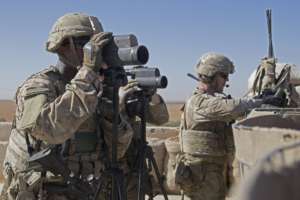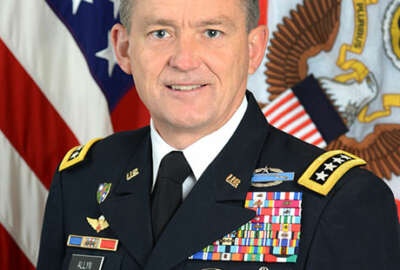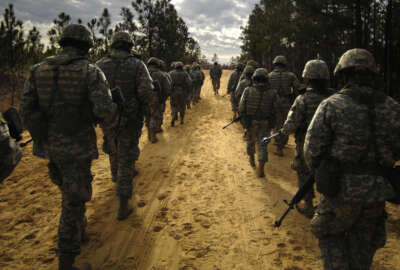
Data analytics, focus on cities are key to Army’s aim to grow its force
The Army plans to arm its recruiters with neighborhood-by-neighborhood market research data and diversity its marketing messages in an effort to boost accession...
Best listening experience is on Chrome, Firefox or Safari. Subscribe to Federal Drive’s daily audio interviews on Apple Podcasts or PodcastOne.
Amid a growing economy and a demand to grow the force, the Army missed its 2018 recruiting goal for the first time in more than a decade. But officials are hoping to avoid a repeat via a recruiting overhaul now in the works, including a change in geographic focus and a new reliance on data analytics.
In the active duty force, the Army was aiming toward a 2018 goal of 76,500 new soldiers, but only managed 70,000. Service leaders think there are a multitude of reasons the Army fell short, but some of them have to do with national demographics.
 Perhaps most significantly, the areas of the country where populations are growing the most haven’t historically been strongholds of Army recruiting, said Gen. Stephen Townsend, the commander of Army Training and Doctrine Command.
Perhaps most significantly, the areas of the country where populations are growing the most haven’t historically been strongholds of Army recruiting, said Gen. Stephen Townsend, the commander of Army Training and Doctrine Command.
“We have a term, ‘the crooked smile.’ Basically, if you drew a sort of a smiley face on the map of the United States from Virginia southward and then across, that would be the Army’s recruiting strongholds. And for decades we have used that area to offset or mitigate our lack of performance and recruiting in the rest of the country,” he said at an event hosted by the Association of the U.S. Army this week. “That’s just not going to work anymore. The smart youth of America are proliferating, growing, in other parts of the country. We have to step outside that traditional stronghold, and we have to be successful.”
Marketing to untapped areas
In particular, the Army wants to focus on cities where it’s historically had trouble attracting new soldiers. So far, it’s identified 22 where officials think they’ll gain more prospects if they adapt their tactics and messaging.
“For growing populations of 18 to 24-year-olds, these cities have the majority of that population. And some them are not necessarily outside of our traditional stronghold. One example is Georgia: it’s a recruiting powerhouse, but Atlanta is not,” Townsend said. “Houston’s another one. We don’t do so great in Houston even though we do great in Texas. Miami is another. We do great in Florida, we don’t do great in the Miami area, so we’re going to go into those areas and we’re going to win.”
Key to the strategy will be a new marketing approach. In November, the Army awarded a new, $4 billion contract to run its marketing and advertising program. Part of it will involve new research and data analytics capabilities that the Army hopes to use to take a much more surgical view toward its recruiting efforts; tweaking its message slightly depending on the neighborhood where recruiters are operating.
Related Stories
“If you are a politician, before you go into any neighborhood, you know what streets are going to vote which way, you know the themes, the messages that neighborhood wants to hear,” he said. “Our recruiters don’t have that, because no one’s given them that information. They don’t have the intel they need to succeed, so we’ve been doing it with brute force, cold calls, mass canvassing. This market research and market analytics capability we’re standing up will be able to give zip code or neighborhood-level fidelity, and we’re already seeing that with our pilot in Chicago. You’ll see billboards in this one part of the city with one face and message, and you go to a different part of the city and there’s a different face and a different message there, because we’re trying to focus it on the population.”
Reducing recruiters
Currently, the Army has about 10,000 soldiers across the country who are dedicated to recruiting. Townsend said those numbers have been necessary up until now because the Army has felt it needed to flood the country with recruiters in order to achieve the accessions numbers it needed.
The new theory is that the service might be able to gain more recruits with fewer recruiters.
“We’ve got to transform our 20th century, industrial, analog, brute-force recruiting and evolve that into a 21st century, high-tech digital talent acquisition model,” Townsend said. “If we do the reforms that we’re talking about, we could cut the recruiting force by 25 percent, 30 percent, maybe half.”
After previous budgets that put it on a path to shrink to 450,000 active duty soldiers, the Army is now trying to grow its force to 500,000 by 2024.
And progress has been sluggish. Despite having recruited 70,000 soldiers in 2018 — more than in any year in the past decade — the overall size of the force has trended slightly downward. According to the most recent statistics from DoD’s Defense Manpower Data Center, the Army had 471,978 at the end of November 2018, 2,519 fewer than at the same time a year before.
A new ad campaign
Among the challenges: only about one-third of 18 to 24-year-old Americans meet the Army’s physical standards. And within that group, only about 17 percent are “propensed” to join any military service.
But Townsend argued that’s largely due to a lack of understanding among the general population about what the military actually does.
“We’re developing digital solutions to engage the youth population and their key influencers on the benefits of service,” he said. “When you ask the young folks, ‘Why wouldn’t you even consider service?’ They say, ‘Well, I don’t really know anything about it.’ If you give them just a quick three-minute information brief on what your armed forces are, what they do for the country and the benefits of service, that number jumps up by about double. So we’ve got to get that word out.”
Part of that messaging includes a new advertising strategy.
The Army has released four new TV commericals in the past several months. The first, hard-charging phase of the ad campaign, dubbed “Warriors Wanted,” emphasizes soldiers’ high-end combat missions.
But Townsend said the Army also knows it needs to diversify its marketing messages.
“When I saw that first commercial, I said, ‘Sign me up right now — I’m ready to go for another 30 years.’ But it doesn’t attract everybody,” he said. “There are folks who are interested in STEM and high tech. So the next series of commercials is going to be one that I hope will show some technical fields: [Unmanned aerial vehicles], aircraft repair, cyber, those kinds of things.”
Copyright © 2024 Federal News Network. All rights reserved. This website is not intended for users located within the European Economic Area.
Jared Serbu is deputy editor of Federal News Network and reports on the Defense Department’s contracting, legislative, workforce and IT issues.
Follow @jserbuWFED





